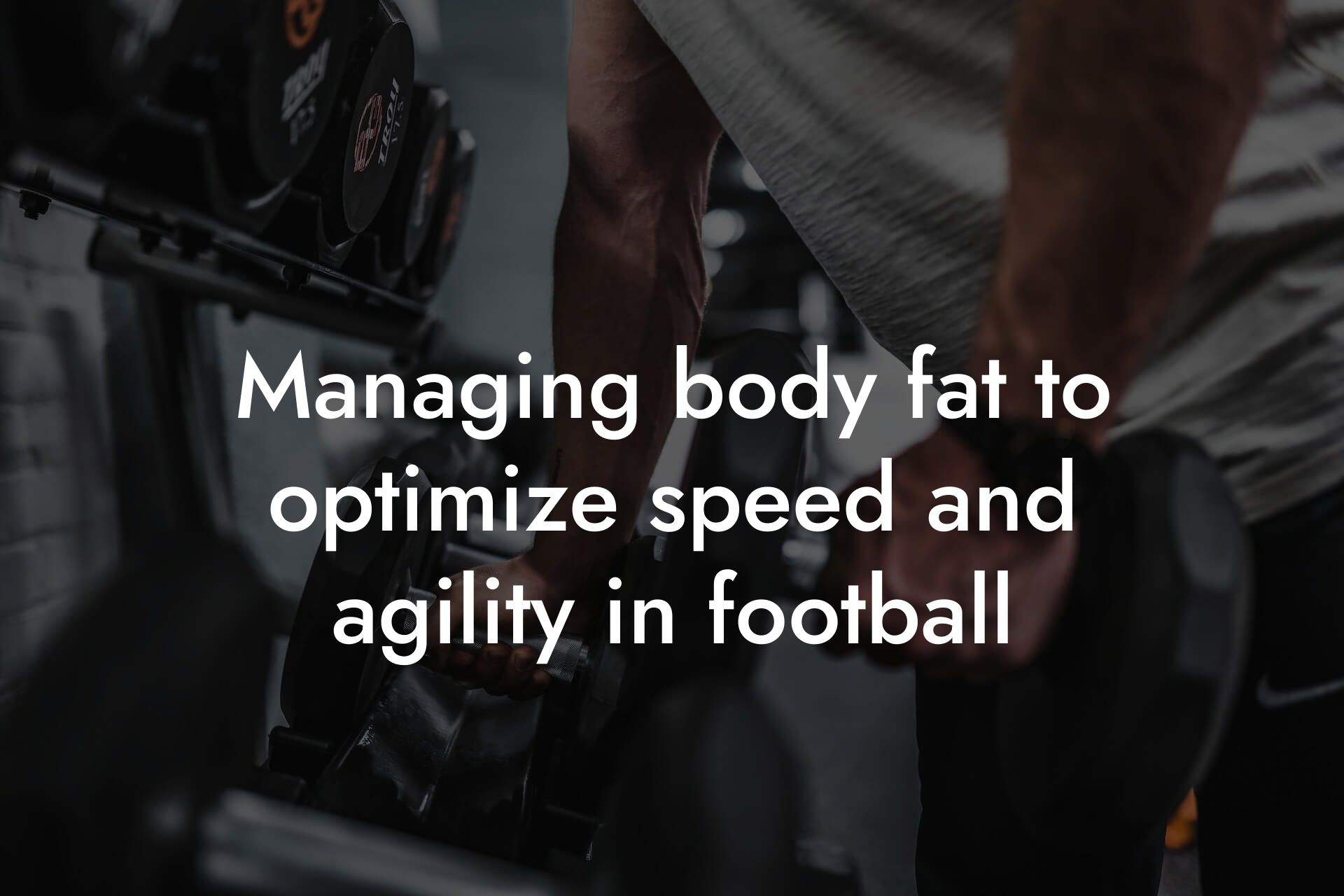As a football player, the off-season is a critical period to focus on your fitness and conditioning. It's a time to recharge, rebuild, and refocus on your goals, ensuring you return to the field stronger, faster, and more agile than ever. At Tano Performance Group, we understand the importance of a well-structured off-season fitness program, which is why we've put together this comprehensive guide to help you optimize your training and take your game to the next level.
Table of Contents
- Why Off-Season Training is Crucial for Football Players
- Components of an Effective Off-Season Fitness Program
- Periodization: A Key to Success in Off-Season Training
- Sample Off-Season Workout Routine
- Importance of Body Composition Analysis in Off-Season Training
- Common Mistakes to Avoid in Off-Season Training
- Frequently Asked Questions
Why Off-Season Training is Crucial for Football Players
The off-season provides a unique opportunity to address any weaknesses, imbalances, or limitations in your game. It's a time to work on your overall fitness, strength, power, speed, and agility, allowing you to dominate on the field when the season begins. A well-designed off-season fitness program can help you:
- Improve your overall athleticism
- Increase your strength and power
- Enhance your speed and agility
- Boost your endurance and stamina
- Reduce your risk of injury
- Gain a competitive edge over your opponents
Components of an Effective Off-Season Fitness Program
A comprehensive off-season fitness program should include a combination of the following components:
- Strength Training: Focus on exercises that improve your overall strength, power, and muscle mass, such as squats, deadlifts, bench press, and rows.
- Conditioning: Incorporate exercises that improve your cardiovascular endurance, speed, and agility, such as sprints, hill sprints, and shuttle runs.
- Plyometrics and Power Training: Incorporate explosive exercises like jump squats, box jumps, and medicine ball throws to improve your power and acceleration.
- Flexibility and Mobility: Incorporate stretching and mobility exercises to improve your range of motion, reduce muscle imbalances, and prevent injuries.
- Nutrition and Recovery: Focus on optimal nutrition and recovery strategies to support your training, including adequate protein intake, hydration, and sleep.
Periodization: A Key to Success in Off-Season Training
Periodization is a training methodology that involves dividing your off-season into specific phases, each with a unique focus and goal. This approach allows you to:
- Avoid plateaus and prevent overtraining
- Progressively overload your muscles and cardiovascular system
- Ensure a balanced and well-rounded fitness program
A typical off-season periodization plan may include the following phases:
- Phase 1: Hypertrophy and Strength (Weeks 1-4)
- Phase 2: Power and Speed (Weeks 5-8)
- Phase 3: Conditioning and Endurance (Weeks 9-12)
- Phase 4: Active Recovery and Maintenance (Weeks 13-16)
Sample Off-Season Workout Routine
Here's a sample off-season workout routine that incorporates the components and periodization principles outlined above:
- Monday (Strength Training): Squats, deadlifts, bench press, rows, and lunges
- Tuesday (Conditioning): Sprints, hill sprints, and shuttle runs
- Wednesday (Rest Day)
- Thursday (Plyometrics and Power Training): Jump squats, box jumps, and medicine ball throws
- Friday (Strength Training): Leg press, shoulder press, and bicep curls
- Saturday (Conditioning): Pro Agility Shuttle and 300-yard shuttle
- Sunday (Rest Day)
Importance of Body Composition Analysis in Off-Season Training
At Tano Performance Group, we understand the importance of body composition analysis in off-season training. Our state-of-the-art DEXA machine provides a comprehensive assessment of your body composition, including:
- Body fat percentage
- Lean muscle mass
- Bone density
- Visceral fat
This information allows you to:
- Track changes in your body composition over time
- Identify areas for improvement
- Optimize your nutrition and training strategies
- Gain a competitive edge over your opponents
Common Mistakes to Avoid in Off-Season Training
Here are some common mistakes to avoid in off-season training:
- Insufficient periodization and progressive overload
- Inadequate nutrition and recovery strategies
- Overemphasis on strength training and neglect of conditioning
- Inadequate flexibility and mobility training
- Ignoring body composition analysis and tracking
In conclusion, a well-structured off-season fitness program is essential for football players looking to improve their performance, gain a competitive edge, and reduce their risk of injury. By incorporating the components and periodization principles outlined in this guide, you'll be well on your way to achieving your goals. Remember to track your progress, avoid common mistakes, and prioritize body composition analysis to optimize your training. At Tano Performance Group, we're committed to helping you take your game to the next level. Contact us today to learn more about our DEXA body composition analysis and personalized training programs.
Frequently Asked Questions
What is the purpose of an off-season fitness program for football players?
An off-season fitness program for football players is designed to improve their overall fitness, strength, speed, and agility during the period when they are not actively competing. The goal is to enhance their physical abilities, reduce the risk of injury, and prepare them for the demands of the upcoming season.
Why is it important for football players to stay active during the off-season?
Staying active during the off-season helps football players maintain their physical fitness, prevent detraining, and avoid losing the progress they made during the previous season. It also allows them to work on specific skills, address weaknesses, and improve their overall performance.
What are the benefits of a structured off-season fitness program?
A structured off-season fitness program provides a clear plan, accountability, and a focus on specific goals. It helps football players improve their strength, power, speed, agility, and endurance, while also reducing the risk of injury and improving their overall health and well-being.
How long should an off-season fitness program last?
The duration of an off-season fitness program can vary depending on the individual player's goals and needs. Typically, it can last anywhere from 8 to 16 weeks, with a gradual progression from general fitness to specific football-related skills.
What types of exercises should be included in an off-season fitness program?
A comprehensive off-season fitness program should include a combination of strength training, power development, plyometrics, agility drills, and cardiovascular exercises. It should also incorporate exercises that target specific muscle groups, such as the legs, core, and upper body.
How often should football players train during the off-season?
The frequency of training during the off-season depends on the individual player's goals and current fitness level. A general rule of thumb is to train 3-4 times per week, with at least one day of rest in between. This allows for adequate recovery time and reduces the risk of overtraining.
What is the importance of nutrition during the off-season?
Nutrition plays a critical role in an off-season fitness program. A well-planned diet provides the necessary fuel for training, supports muscle growth and repair, and helps with recovery. Football players should focus on consuming a balanced diet that includes plenty of protein, complex carbohydrates, and healthy fats.
How can football players stay motivated during the off-season?
Staying motivated during the off-season can be challenging, but there are several strategies that can help. These include setting specific goals, finding a training partner, tracking progress, and rewarding oneself for milestones achieved. Additionally, football players can stay motivated by reminding themselves of their why and the benefits of their hard work.
What role does recovery play in an off-season fitness program?
Recovery is a critical component of an off-season fitness program. It allows football players to repair and rebuild their muscles, replenish energy stores, and adapt to the demands of training. Adequate recovery time, including rest, stretching, and foam rolling, is essential for optimal performance.
How can football players incorporate mental preparation into their off-season training?
Mental preparation is a crucial aspect of an off-season fitness program. Football players can incorporate mental preparation by practicing visualization techniques, setting goals, and developing a positive mindset. They can also work on their mental toughness by engaging in activities that challenge them outside of their comfort zone.
What are some common mistakes football players make during the off-season?
Common mistakes football players make during the off-season include not having a structured program, neglecting nutrition and recovery, and not addressing weaknesses or imbalances. They may also focus too much on one aspect of their fitness, such as strength or speed, and neglect other important areas.
How can football players balance their off-season training with other responsibilities?
Balancing off-season training with other responsibilities, such as work or school, can be challenging. Football players can prioritize their time, create a schedule, and learn to say no to non-essential commitments. They can also find ways to incorporate training into their daily routine, such as exercising during lunch breaks or finding a gym that is close to their work or school.
What are some signs that a football player needs to adjust their off-season training?
Signs that a football player needs to adjust their off-season training include plateaus, injuries, or feelings of burnout. They may also experience decreased motivation, poor performance, or a lack of progress towards their goals. If a football player experiences any of these signs, they should reassess their program and make adjustments as needed.
How can football players measure their progress during the off-season?
Football players can measure their progress during the off-season by tracking their workouts, monitoring their body fat percentage, and assessing their performance in specific exercises or drills. They can also use metrics such as speed, agility, and strength to evaluate their progress.
What role does sleep play in an off-season fitness program?
Sleep is essential for recovery and adaptation during an off-season fitness program. Football players should aim to get 7-9 hours of sleep per night to allow their bodies to repair and rebuild. Poor sleep can negatively impact performance, increase the risk of injury, and hinder progress.
How can football players stay accountable during the off-season?
Football players can stay accountable during the off-season by finding a training partner, hiring a coach or trainer, or joining a fitness group. They can also set specific goals, track their progress, and reward themselves for milestones achieved.
What are some common injuries that can occur during the off-season?
Common injuries that can occur during the off-season include muscle strains, tendonitis, and overuse injuries. Football players can reduce their risk of injury by incorporating injury prevention exercises, listening to their bodies, and taking regular breaks.
How can football players incorporate injury prevention into their off-season training?
Football players can incorporate injury prevention into their off-season training by including exercises that target specific muscle groups, such as the hamstrings, glutes, and core. They can also incorporate proprioception exercises, balance training, and plyometrics to improve their overall functional strength and reduce their risk of injury.
What are some benefits of working with a personal trainer or coach during the off-season?
Working with a personal trainer or coach during the off-season can provide football players with a customized program, accountability, and expert guidance. A trainer or coach can help players identify areas for improvement, develop a structured program, and provide feedback and support throughout the off-season.
How can football players make the most of their off-season training?
Football players can make the most of their off-season training by setting specific goals, creating a structured program, and staying committed to their training. They should also prioritize nutrition, recovery, and sleep, and be open to making adjustments as needed.
What are some common misconceptions about off-season training for football players?
Common misconceptions about off-season training for football players include the idea that it's only about getting bigger and stronger, or that it's unnecessary. Another misconception is that off-season training should focus solely on football-specific skills, neglecting other important aspects of fitness such as strength, power, and endurance.
How can football players incorporate flexibility and mobility exercises into their off-season training?
Football players can incorporate flexibility and mobility exercises into their off-season training by including exercises such as stretching, foam rolling, and dynamic movements. They can also incorporate exercises that target specific muscle groups, such as the hamstrings, hip flexors, and lower back.
Here are some related articles you might love...
- The role of bone density in preventing football injuries
- Managing body fat to optimize speed and agility in football
- Nutrition strategies for maintaining muscle mass during the football season
- Recovery strategies for football athletes: Nutrition and rest
- Balancing mass and speed: A guide for football athletes
- How DEXA scans can benefit professional football players
- How to maintain peak performance during the football season
- The importance of body composition in football performance
- Strength training tips for football players
Zak Faulkner
Zak Faulkner is a leading authority in the realm of physical health and body composition analysis, with over 15 years of experience helping professionals optimise their fitness and well-being. As one the experts behind Tano Performance Group, Zak has dedicated his career to providing in-depth, science-backed insights that empower clients to elevate their physical performance and overall health.
With extensive knowledge of DEXA technology, Zak specializes in delivering comprehensive body assessments that offer precise data on body fat, muscle mass, bone density, and overall physique. His expertise enables individuals to make informed decisions and achieve their fitness goals with accuracy and confidence. Zak’s approach is rooted in a deep understanding of human physiology, combined with a passion for helping clients unlock their full potential through personalised strategies.
Over the years, Zak has earned a reputation for his commitment to excellence, precision, and client-focused service. His guidance is trusted by top professionals who demand the best when it comes to their health. Whether advising on fitness programs, nutritional strategies, or long-term wellness plans, Zak Faulkner’s insights are a valuable resource for anyone serious about taking their health and fitness to the next level.
At Tano Performance Group, Zak continues to lead our Content Team revolutionising how professionals approach their physical health, offering unparalleled expertise that drives real results.




